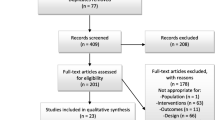Abstract
About 15 % of all diabetes patients experience foot complication at some stage in their life. The goal of this review is to systematically assess on effectiveness of multidisciplinary teamwork compared to the standard care in risk reduction of diabetes-related foot complications with a primary and secondary outcome. Literatures of only English language were analyzed under strict inclusion criteria from electronic databases search. Result from overall pooled estimate up to 0.65 % reduction, with 95 % CI (p < 0. 005) in foot ulceration and amputation using a multidisciplinary team care as a tool compared to the standard care in primary outcome. Evidence also supports program benefits in overall cost (0.6 % reduction, p < 0.005), rate of hospitalization (80 % dropped, p < 0.003), and patient quality of life as secondary outcomes. Study’s characteristic differed substantially in term of health care setting, nature of interventions, and outcomes measured reported. Evidently, multidisciplinary team efforts from specialists in diabetes, vascular and infectious disease, along with podiatry expertise and patient educators result in a significant reduction in diabetes-related foot complications compared to the standard care.


Similar content being viewed by others
References
World Diabetic Foundation: Diabetes facts; Available at: www.worlddiabetesfoundation.org/ (2010) Accessed April 2012.
International Diabetes Federation: Foot facts. Available at: http://www.idf.org/webdata/docs/Foot_Facts_EN.pdf (2008) Accessed Jan 16 2011.
IWGDF: Prevalence and global impacts of diabetes, Available at: www.iwgdf.org (2010) Accessed, July 28, 2011.
IWGDF: 5th International Symposium on The Diabetic Foot. Available at: http://www.diabeticfootjournal.co.uk/article-paginated page.php?contentid=2128&issueid=96&page=1&memid=9329&se=1&searchphrase=tanzania (2007) Accessed 20 Jan 2012.
Helmer D, Tseng CL, Wrobel J, Tiwari A, Rajan M, Pogach L, et al. Risk factor for diabetic foot care. Diabetes Care. 2011;34(8):1695–700.
Graham PL. Review: the varied attractions of the diabetic foot. Br J Diabetes Vasc Dis. 2009;9(4):155–9.
Ramachandran A. Specific problems of the diabetic foot in developing countries. Diabetes Metab Res Rev: Pub Med. 2004;20(1):S19–22.
Jan D: Complex interventions for preventing diabetic foot ulceration; Available at: onlinelibrary.wiley.com (2010) Accessed 12 July 2011.
Tulley, S: Diabetes and “Traditional” medicine; Available at: http://www.iwgdf.org/index.php? (2007) Accessed May 2011.
Braid S, Stuart L.: India: diabetic foot care in the developing world. Available at: http://www.diabeticfootjournal.co.uk (2009) Accessed Jan 115 2012.
Canavan RJ, Unwin NC, Kelly WF, Connolly VM. Diabetes- and non diabetes-related lower extremity amputation incidence before and after the introduction of better organized diabetes foot care: continuous longitudinal monitoring using a standard method. Diabetes Care. 2007;31(3):459–63.
Jefcoat W.: Putting Feet First: Halving the number of major amputations in diabetes by 2013. Available at: http://www.diabeticfootjournal.co.uk/article-paginated- (2010) Accessed 23 Jan 2012.
Watkins PJ. The diabetic foot. BMJ. 2003;326(7396):977–9.
CRD. Systematic reviews: CRD’s guidance for undertaking reviews in healthcare. University of York: Center for Reviews and Dissemination. (2009).
Higgins JPT, Green S. Cochrane handbook for systematic reviews of interventions version 5.1.0 [The Cochrane Collaboration] updated http://handbook.cochrane.org/chapter_8/8_assessing_risk_of_bias_in_included_studies.htm (01, 2015) (2011).
Rerkasem K, Kosachunhanun N, Tongprasert S, Khwanngern K, Matanasarawoot A. Reducing lower extremity amputations due to diabetes: the application of diabetic-foot protocol in Chiang Mai University Hospital. Int J Low Extrem Wounds. 2008;7(2):88–92.
Yesil S, Akinci B, Bayraktar F, Havitcioglu H, Karabay S, Demirdover C, et al. Reduction of major amputations after starting a multidisciplinary diabetic foot care team: single centre experience from Turkey. Thieme eJournal (Pub Med). 2009;117(7):345–9.
Abbas ZG, Lutale JK, Bakker K, Baker N, Archibald LK. The ‘Step by Step’ diabetic foot project in Tanzania: a model for improving patient outcomes in less-developed countries. Int Wound J. 2011;8(2):169–75.
Peters EJ, Lavery LA. Effectiveness of the diabetic foot risk classification system of the International Working Group on the Diabetic Foot. Diabetes Care. 2001;24(8):1442–7.
Anichini R, Zecchini F, Cerretini I, Meucci G, Fusilli D, Alviggi L, et al. Improvement of diabetic foot care after the implementation of the International Consensus on the Diabetic Foot (ICDF): results of a 5-year prospective study. Diabetes Res Clin Pract. 2007;75(2):153–8.
Lincoln NB, Radford KA, Game FL, Jeffcoate WJ. Education for secondary prevention of foot ulcers in people with diabetes: a randomized controlled trial. Diabetologia. 2008;51(11):1954–61.
Schmidt S, Mayer H, Panfil EM. Diabetes foot self-care practices in the German population. J Clin Nurs. 2008;17(21):2920–6.
Ronald HL, Birke JA, Patout CA. A staged management diabetes foot program versus standard care: a 1-year cost and utilization comparison in a state public hospital system. Arch Phys Med Rehabil. 2003;84(12):1743–6.
Boutoille D, Féraille A, Maulaz D, Krempf M. Quality of life with diabetes-associated foot complications: comparison between lower-limb amputation and chronic foot ulceration. Foot Ankle Int. 2008;29(11):1074–8.
Rerkasem K, Kosachunhanun N, Togprasert S, Guntawongwan K. A multidisciplinary diabetic foot protocol at Chiang Mai Univerity Hospital; cost and quality of life. Int J Low Extrem Wounds. 2009;8(3):153–6.
Andrews KL, Houdek MT, Kiemeli LJ. Wound management of chronic diabetic foot ulcers: from the basics to regenerative medicine. Prosthetics Orthot Int. 2015;39(1):29–39.
Martínez-Gómez DA, Moreno-Carrillo MA, Campillo-Soto A, Carrillo-García A, Aguayo-Albasini JL. Reduction in diabetic amputations over 15 years in a defined Spain population. Benefits of a critical pathway approach and multidisciplinary team work. Rev Esp Quimioter. 2014;27(3):170–9.
Weck M, Slesaczeck T, Paetzold H, Muench D, Nanning T, von Gagern G, et al. Structured health care for subjects with diabetic foot ulcers results in a reduction of major amputation rates. Cardiovasc Diabetol. 2013;12:45.
Rubio JA, Aragón-Sánchez J, Jiménez S, Guadalix G, Albarracín A, Salido C, et al. Reducing major lower extremity amputations after the introduction of a multidisciplinary team for the diabetic foot. Int J Low Extrem Wounds. 2014;13(1):22–6.
Spanos K, Lachanas V, Karathanos C, Poredos P, Hussein E, Giannoukas AD. A survey on the status of the management of diabetic foot in the Mediterranean region; Int Angiol; (2015) PMID 25677222.
Clerici G, Faglia E. Saving the limb in diabetic patients with ischemic foot lesions complicated by acute infection. Int J Low Extrem Wounds. 2014;13(4):273–93.
Piaggesi A, Coppelli A, Goretti C, Iacopi E, Mattaliano C. Do you want to organize a multidisciplinary diabetic foot clinic? We can help. Int J Low Extrem Wounds. 2014;13(4):363–70.
Manu CA, Mustafa OG, Bates M, Vivian G, Mulholland N, Elias D, et al. Transformation of the multidisciplinary diabetic foot clinic into a multidisciplinary diabetic foot day unit: results from a service evaluation. Int J Low Extrem Wound. 2014;13(3):173–9.
Sue Tulley, Foster A, Putten MV, Vilma Urbancic-Rovan, Bakker K. Diabetic foot care training in developing countries; addressing the skills shortage. The Diabetic Foot Journal. (2009);12 (1).
Compliance with ethical standards
We wish to confirm that there are no known conflicts of interest associated with this publication and there has been no significant financial support for this work that could have influenced its outcome.
We confirm that the manuscript has been read and approved by all named authors and that there are no other persons who satisfied the criteria for authorship but are not listed. We further confirm that the order of authors listed in the manuscript has been approved by all of us.
We confirm that we have given due consideration to the protection of intellectual property and that all ethical obligations and consideration associated with this work were carefully fulfilled and that there are no impediments to publication, including the timing of publication, with respect to intellectual property. In so doing, we confirm that we have followed the regulations of our institutions concerning ethical guidelines and intellectual property.
Author information
Authors and Affiliations
Corresponding authors
Rights and permissions
About this article
Cite this article
Khan, N., Sapsed, S. Diabetes foot complication: assessing primary and secondary outcomes of multidisciplinary team versus standard care (a systematic review). Int J Diabetes Dev Ctries 37, 129–136 (2017). https://doi.org/10.1007/s13410-015-0422-0
Received:
Accepted:
Published:
Issue Date:
DOI: https://doi.org/10.1007/s13410-015-0422-0




